Do you want to learn how to ride an electric skateboard? Then this article is exactly for you. I’m an electric skateboarder myself and crafted with a lot of research and my own knowledge this beginner’s guide.
First, you want to be sure that you find your right front and your right back food. Second, having a solid stance on an electric skateboard is crucial for your safety. Third, you should get familiar with your e-board in your remote control. Now it is time to open the throttle the first time. After that its time for practicing how to break with an electric skateboard. If you’re able to execute accelerating and braking we can to move on to learning how to make turns. Now that you know the fundamentals be sure to get to know your board and practice, practice, practice! There are a few more things to consider: the traffic, basement quality, and additional breaking techniques. In this beginners guide, you will learn the fundamentals. Let’s get ready for our electric skateboarding adventures!
Follow these simple steps:
- Finding your front and back foot
- Having a solid stance on an electric skateboard
- Accelerating – Open the throttle
- Braking
- Making turns
- Get to know your board and Practice, Practice, Practice!
Finding your front and back foot
Regular or Goofy?
When you’re just starting out with electric skateboarding the first thing we need to be clear of is whether your right or your left foot is your better front foot. In skateboard terms: are you a “Regular” or “Goofy” footed e-skateboarder?
- Goofy-stance: In the goofy stance you will ride with your right foot forward, left foot in the back.
- Regular-stance: In the regular stance you will ride with your left foot forward, right foot in the back.
These are the two different ways of standing on an electric skateboard. But how do we know wich foot is our front and which is our back foot? I researched a variety of tests to get to our answer!
- Ball-Test: Take a self a football or soccer ball and just kick push it. The foot that kicked the ball is your back foot. The foot which is standing is your balancing foot and therefore is your front foot.
- Slide-Test: Get the most slippery socks you have. Search a slippery wooden floor and take a run up and try to slide as long as you can. Your forward foot is not just now your front foot but on your electric skateboard as well.
- Stair-Test: Get yourself a chair or go to a set of stairs and stand still with both of your feet on the floor. Now, intuitively take the first step up. The foot with which you stepped up should be your front foot.
- Tug war-Test: Playtime! You read right, get your friends together and make a tug-war. The foot you put forward is your front foot.
- Board-Test: In my opinion the most reliable and best way to find out if you are a regular or goofy rider. Just get yourself onto a board and ask a friend of yours to assist you. Now try out which stance feels more normal and natural for you. Take the hands of your friend so that you don’t lose balance. Drive a couple of meters in one direction and then into the other direction and see which front foot feels more natural.
TaDa! You just found out whether you are regular or goofy!
Don’t worry if it feels awkward in the beginning. Normally the first few rides in your life on a skateboard or an electric skateboard will feel very unnatural and weird.
If it isn’t clear to you, if both stances feel unnatural or both stances feel more or less the same then don’t worry. Just start with one side and eventually switch to the other side as well. Good skateboarders and good e-skateboarders can drive “switch” that means they can drive regular and goofy. Maybe you are already one step ahead. 😉
Right stance on an electric skateboard
First and foremost you want to be sure that you have the right stance on your electric skateboard. That means that your feet are positioned more or less hip-width apart from each other. You should bend your knees for compensating any concussions or turns. It is a lot easier to hold the balance as well.
You also want to be sure that you’re not leaning too much forward or too much backward. Otherwise, you will lose balance very quickly.
Open the throttle
Unlike a traditional skateboard, most electric skateboards now use a wireless handheld remote control. All controls are featured on the remote to give you instant access to every action.
Figure out every feature on the remote and find an open space to practice.
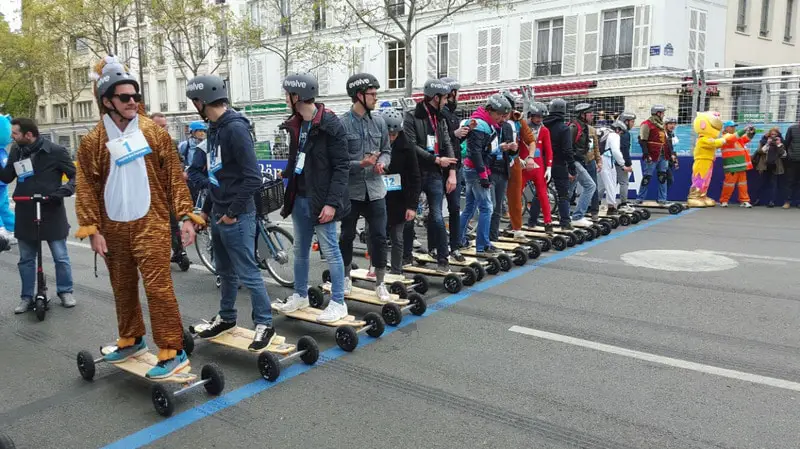
Preparing to open the throttle. Some electric skateboards have immense power in acceleration. You won’t believe how fast they can speed up. Accelerating when you aren’t ready or prepared can be dangerous. The eboard will probably just flip away. Therefore we need to be sure that we prepare ourselves for the acceleration process. Prepare for your weight to be shifted backward when accelerating. bend your knees and squat a little bit down. This way the back leg muscle is already kind of tight and can immediately tense up when the body weight shifts backward. It also lowers the center of gravity so the weight shift is less intense.
- Front foot: When accelerating you want to lean forward, move your weight to your front foot. Bend your knees to lower the center of gravity. Bend your front leg more than your leg in the back.
- Back foot: You want to be sure that your back foot is stable, slightly tensed, and ready for the acceleration. Also try placing your back foot, not at the end of your board. Otherwise, the board can do a wheelie and will slip away. And yes – you will fall. As you accelerate your weight will be forced to your back foot. Once you have overcome the initial acceleration you will feel comfortable to shift your weight around on the board.
There are two main kinds of remote controls (RC) for electric skateboards. The first one is a remote control has got a big trigger on the backside of the RC that you can pull with your index finger. The second kind of RC has a slideable button on the front side of the RC that you can slide up and downwards.
To open the throttle you need to pull the trigger (RC type 1) or push the slideable button with your thumb and forward or up. (RC type 2).
Now you’re ready for the fun part. Open the throttle.
Braking
Braking with an eboard is more or less the reverse action to opening the throttle. Prepare for your weight to be shifted forwards when braking. So lean a little bit backward, bend your knees and squat a little bit down. This way the front leg muscle is already kind of tight and can immediately tense up when the body weight shifts forward. It also lowers the center of gravity so the weight shift is less intense. So: you want to be sure that your front foot is stable, slightly tensed, and ready for the braking.
There are two main kinds of remote controls (RC) for electric skateboards. The first one is a remote control has got a big trigger on the backside of the RC that you can pull with your index finger. The second kind of RC has a slideable button on the front side of the RC that you can slide up and downwards.
To brake, you need to let go of the trigger with your index finger (RC type 1) or push the slideable button with your thumb and downwards or down. (RC type 2).
Practice!
I recommend that you practice your braking in a safe riding area before you perform it on the street. Also, I would recommend that you try out a Full break (very hard break) so that you get used to it. So when you need to brake hard you won’t be surprised and you are able to handle it in a stressful situation.
Now you can take advantage of a major benefit in e-boarding. You don’t need to foot break! You can ride downhill, even very steep gradients, more slowly and safely. The braking system of an electric longboard is very strong so normally you don’t need to add your foot for braking or slowing down. And the best part is that your braking system is a regenerative braking system. So you break and charge your battery simultaneously.
The fact that makes electric skateboarding amazing is that you have access to brakes now!

Making Turns with your eboard
Electric skateboarding is not a lot of fun without making turns. So we want to be sure that we all got our turns right. Cruising and carving on an electric longboard will be a bit different than on normal skate- or longboards. The length, width, weight and tense trucks reduce their maneuverability but also makes them stable. You can adjust the tightness of the trucks which will affect how sloppy or tight your turning is.
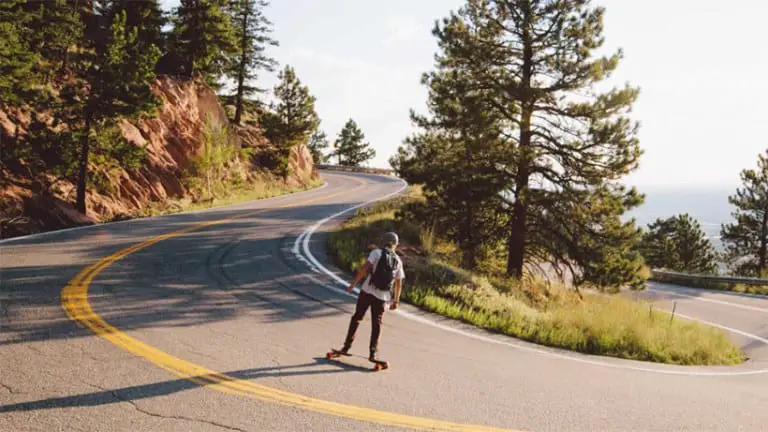
How to make a turn: you need a stable stance on your electric longboard. Push the throttle and drive straight forward. Now you shift your body weight slightly to your toes or your heels for making turns.
Frontside turn: Move your body weight slightly to your toes. This is called a toeside turn. Which means if you have your left foot in the front you will turn to the right. The center or midpoint of the turn radius is located in the front of yourself. Therefore, frontside turn.
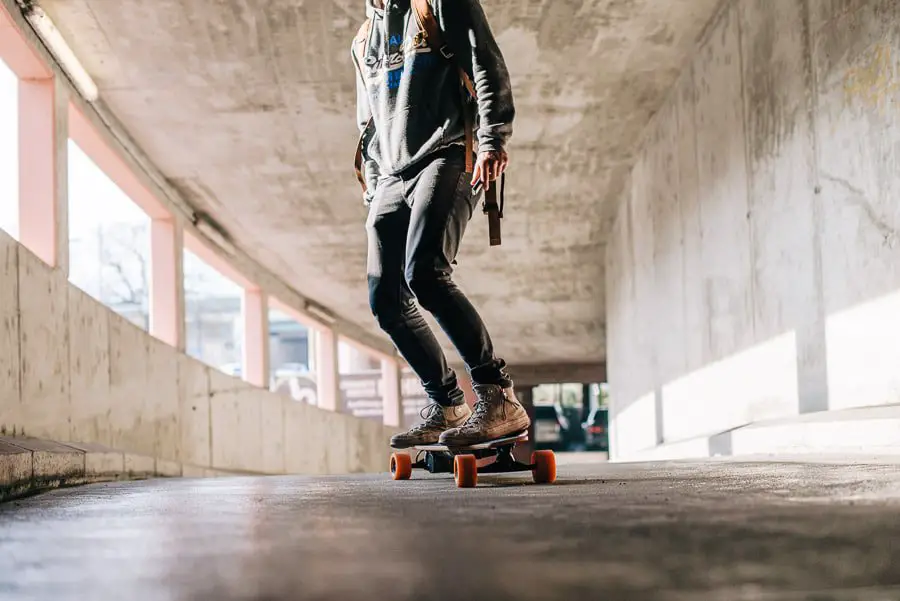
Backside turns: to make a backside turn you have to shift your weight slightly to your heels. (heelside turn) That means if your left foot is your front foot you’re making a turn to the left. The center of your turn radius is located in the back of your body so – backside turn.
Another tip: Keep your head up and look in the direction you want to go. If you want to turn right look to the right. If you want to turn left look to the left. If you’re looking at a tree that’s where you will end up. So please be sure to look in the direction you want to go.
Get to know your board and Practice, Practice, Practice!
Get to know your eboard and get to know its setup. Try to find the traction points, the acceleration point, the breaking point, and your turning radius. Figure out every feature on the remote and find an open space to practice. Just learn how your board get around corners, how it behaves, and how it overall feels. You will learn all these things when you’re actually riding your e skateboard. The more you ride your board in a safe area the better. It is a simple advice but a very effective one: practice practice practice! Unlike a traditional skateboard, most electric skateboard now uses a wireless handheld remote. All controls are featured on the remote to give you instant access to every action.
It will make your riding experience a lot easier and better!
Some more things to consider
Kick-Pushing
Kick-pushing is important in normal skateboarding or longboarding. You technically don’t need it as an electric skateboarder. In fact, my opinion the most convenient part of an electric skateboard is that you don’t have to execute a kick push to get forward rolling. Thank you technology!

But kick-pushing is important for saving energy and battery charge! The accelerating process is the part of the ride which consumes the most energy.
Additionally, sometimes your battery will be empty and needs to be recharged. If you are not paying enough attention then your battery could be empty in the middle of your way. Sometimes you don’t want to be called out by the police having an electric skateboard. Then you want to rather be stealthy and kick push your skateboard forward.
It’s rarely the case but sometimes the motor will fail and you have to kick push your skateboard home. In these cases, we want to be sure that we are able to execute a kick push.
How to do a kick push:
First, you have to rotate your front foot to the side. So that the toes will point in the direction you are riding and the heels point to the back of your eboard. Now you can move your entire weight to the front foot. Before that, you want to be sure that you can hold your balance single legged on the normal floor. (without having an unstable rolling board under yourself) This is one of the most difficult parts of skateboarding!
Now you can take your back foot and move it to the side. At this point, you should be able to push the floor with you backfoot besides your electric skateboard. And this it is – the kick-push!
Foot Braking
Foot braking is like kick-pushing very important in ordinary skateboarding or longboarding. But you don’t need it normally as an electric skateboarder. In my opinion, a big advantage in eboarding is that you don’t need to perform a foot braking to slow down or even stop. Thank you e-skateboards!
But sometimes the regenerative braking system of your eboard is not sufficient enough to slow you down. You even could forget to charge the battery of your remote control. Without remote control no braking.
- No battery in the remote control – no signal – no brakes.
- An empty battery in your board – no brakes.
- If the battery of your board is fully charged, the regenerative braking of some boards will not work to not overcharge and therefore harm the battery.
- There is also still a small percentage that your braking system will fail without any impact from the outside.
Let’s not hope for that! (Knock on wood) But in these cases, you want to be sure to execute a foot braking.
How to do a foot braking:
Foot braking works similarly to kick pushing. You need to turn your front foot sideways so that the tip of your foot points in your driving direction and the heel of your foot points to the backside of your board. Now you can take your back foot from the board. (you need to stand on one foot for a short moment) Put your back foot slowly and gently on the street to generate some friction. Be sure to be very gentle at the beginning of friction building. When you have grown enough friction your speed will decrease and you eventually come to a stop.
Emergency Braking
Emergency braking is an initiative that you hopefully never need. You need emergency braking if your normal braking system doesn’t work and other braking techniques (foot braking, carving, sliding) cannot be performed. So basically an emergency brake it the last thing to do before it is coming to a crash.
In this action, you need to jump off the board. If your speed is not that high you should be able to run beside the board and slow down on foot. Be sure to catch your board before it can harm other people.
If your speed is too high and you’re not able to run beside the board you can jump off the board at a grassy patch (if available). To not hurt yourself a lot you can perform a “ninja roll” or “judo roll”.
How to do an emergency braking:
Drop your front shoulder, tuck your head and arms to your body and roll out the speed.
As mentioned already above in the article we want to be sure that we trained enough to execute an emergency braking.
Different Stances
Whether you’re just cool cruising or going into full turbo fast we can actually stand on your board which is called your stance. so in this article we’re going to review the different types of stances.
- Snowboard stance:
This is the most stable stance. Front foot 10° angle, Back foot 0° angle.
The snowboard stance it’s a wider stance. You are standing shoulder width on the board. Your arms are open, a little bit further than the shoulder width. With the snowboard stance, you can do nice wide stable turns. It is the allrounder stance and the most stable stance. It will serve you at low and high speeds.
- Surf Stance:
more turning radius, more curvey, both feet 15°
- Speed Stance:
The last stance is the speed stance. This is for the turbo riders. if you really want to be mocking and go past 30 km/h or more. Your back foot is going to be perpendicular to your board and placed more to the end of the eboard. You should lean a little forward and because of that, the heel of your back foot will lift up from the board. Your back knee will touch your front knee and be an additional stabilizer. This technique is for stabilizing yourself and the board at high speeds. The stance is perfect for reducing wind resistance. Give it a try.
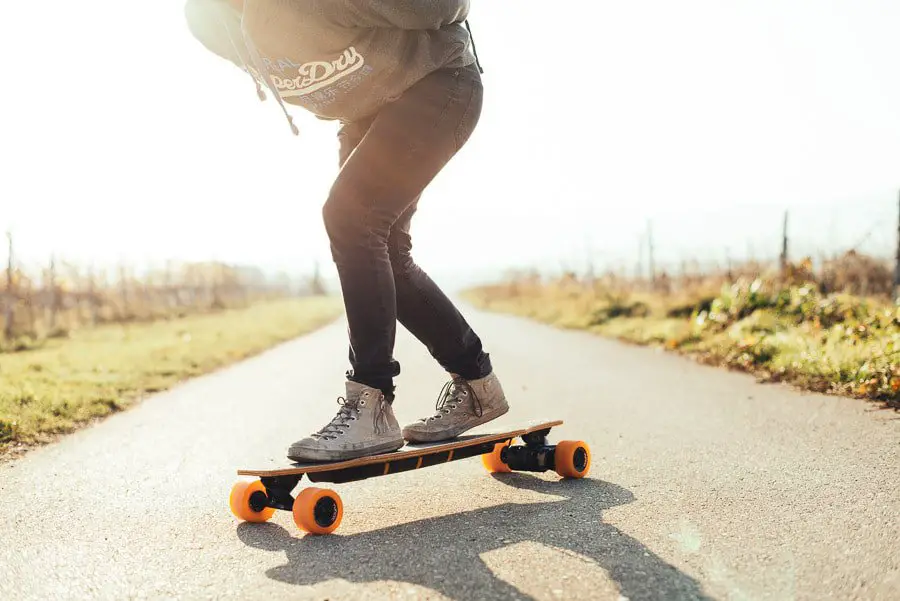
Traffic
Please don’t underestimate the traffic. bicycles, cars, and the trucks can be very very dangerous to us as electric skateboarders. Even as a normal skateboarder traffic can be dangerous. But with the elevated speed of an eboard we need to be sure that we can judge and predict traffic well.

Your driveway will vary. In big cities, there are sometimes special bicycle paths which are separated from the normal street. (Especially in Europe) As an e-border, I’m happy to see these. On these only bikers, inline-skaters and skateboarders drive. So we won’t interfere a lot with heavy traffic except in crossways.
But often there isn’t a so-called bicycle path. We need to decide if we drive on Street or on the sidewalk. The legal status is from country to country and state to state differently. In some countries it is only allowed to drive on the street in other countries it is only allowed to drive on the sidewalk. (Check out my legal guide here)
Normally electric skateboarders drive on the street. The street is much broader and wider. We can accelerate, break and ride fast more safely. We have much more space to make turns. Rides are just more fun on the street, especially without traffic!
The sidewalk can be very useful but it’s often too narrow and small to ride safely and fast. additionally, pedestrians can be very dangerous and unpredictable. Sometimes they change their walking direction quickly. With an electric skateboard, we are often just too fast to avoid these kind of accidents.
Street and asphalt quality
Another big thing to consider when riding an electric skateboard is the street or pavement quality. Potholes, rails, and speedbumps can be very dangerous for an e-skateboarder. Just minor bumps and holes can be dangerous for us. Small wheels on an electric skateboard and week suspension of skateboard trucks cannot compensate all concussions.
To ride an electric skateboard safely we have to look out for any kind of dangers on the street. I am constantly scanning the street and pavement in front of me. If I can avoid just minor potholes and bumps I will do so.

Additional (15) tips for riding safely
- Practice and train additional braking techniques. I´ve written it already a few times in this article. It is important that we practice and train breaking techniques when normal regenerative braking system fails.
- Plan for the worst case scenario – Practice “the right fall” This tip maybe sounds obvious, but be honest. Have you ever practiced to fall right? Do you know how to fall right, so you won’t injure yourself? I doubt that. Once again: Sometimes you ride with an eboard with speeds compared to a motorcycle. If you take a fall at high-speed on asphalt you want to be sure that you know how to fall correctly.
- Do basic maintenance regularly – especially brakes. I think this is a no-brainer. Please maintain your eboard regularly. Check your wheels, trucks, brakes, bearings, remote control, battery, truck tightness and even all the screws that hold your electric skateboard together. (especially if you ride rough surfaces)
- Make sure your batteries are charged (remote control too) Before you take a ride just check the battery of your board. Without charging the battery you won’t have acceleration and braking. And be sure to check the battery of your remote control too! If you don’t have juice in your battery your remote control then you don’t have acceleration nor breaking.
- Make sure you’re being seen – (nighttime = light time) Have you ever seen a bike rider cycling through the night without any lights? Don’t be that fool and buy some decent lights and reflectors for night riding.
- Be cautious, slow down when you see other people or vehicles. Also a very obvious tip. But sometimes when riding becomes a lot of fun I experience a “flow state”. I sometimes drift in a focused-on-riding and not focused-on-traffic kind of mindset. I will become more careless. Because of that, I can’t stress this enough for myself and maybe for your future self as well. Watch out for traffic, other persons or vehicles. Please don’t let yourself get injured because of negligence.
- Be careful when your passing dogs. Watch out for dogs. Try to get past them very slowly. They don’t seem to like the sound. I have been chased a few times now.
- Ride on biking paths. Don’t go near oncoming traffic and try to stay away from cars and trucks as much as possible.
- Don’t ride beyond your skill level Both in terms of where you ride and at what speed. Riding beyond your skill level can be very dangerous especially at high speeds. Speed wobbles, traffic, negligent car drivers. Skill up so these threats can be eluded. Practice, practice, practice!
- Don’t let inexperienced riders without help nor helmet on your board. Inexperienced electric skateboarders can be very incompetent in judging their riding skills. Inform them about every possible danger and give them a detailed and decent e-board instruction. Give them a helmet and try to help them. Be a guide and hold them by the hand for their first right.
- Be careful when letting young children ride. Same here. We want to let our children riding an electric skateboard, but it can be very dangerous for them. Give them a helmet and try to help them as good as you can, especially for their few first rides.
Bottom line: Being safe is a lifestyle that ensures you will enjoy many more fun skateboard rides. Let me know in the comments below if you have additional safety suggestions.
Electric skateboarding can be so much fun! Enjoy your rides!

Final thoughts
I hope that you have enjoyed reading my extensive guide on “how to ride an electric skateboard”. But even more, I hope that my guide is actually helping you learning how to ride an e-skateboard. Please let me know which tip has helped you the most! If you miss some advice or have more suggestions I am happy to read them and later add them to the guide. Have a nice day!
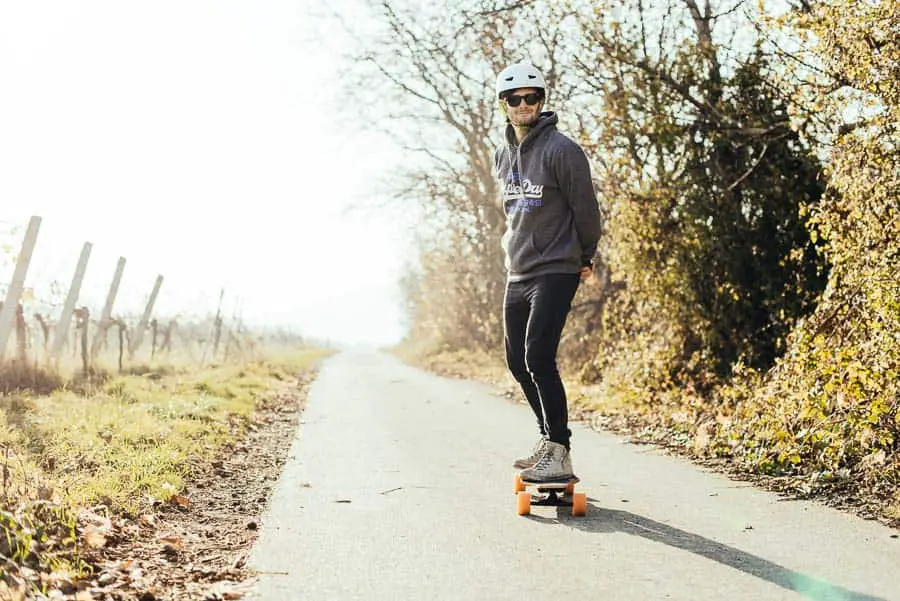
Hey Daniel.
Thanks very much for this well laid out guide. As a 47 year old, who hasn’t been near a board in three decades, it was a great read to help me get the most out of my new electric longboard.
Cheers
Nik
Thanks for your comment! I am happy to help 🙂
which side is usually front? I know that most e-skateboards can reverse the direction. But, in general which side is front? the battery side or the ESC side? I always put ESC side on the driving direction. But i see some do opposite.
Usually, the side where the battery is located is the front side. Vice-versa ESC –> backside.
Hope that helps.
Hey Daniel
The article is very helpful. Here is meant step by step from a beginner level. I have benefited a lot from it. Thank you.
Thank you so much this information was certainly helpful. Learning the proper way to push and pump to speed up my skateboard is important. But the condition of my equipment will also help in increasing my speed.